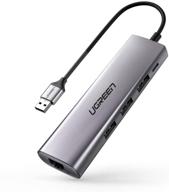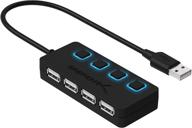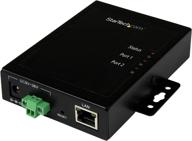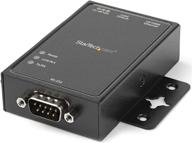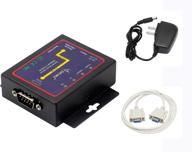What are Device Servers and Why are They Useful?
A device server is a small hardware device that acts as a gateway between computer networks and devices that use other protocols and interfaces. Device servers provide a critical bridging function that allows devices that weren't originally designed to connect to a network to communicate over a standard network, like Ethernet.
Key Functions of a Device Server
- Converts device data to a network-compatible format
- Provides network connectivity for non-networked devices
- Allows remote access and management of devices over a network
- Offloads device connectivity from the host computer
Some common examples of devices that can benefit from a device server include:
Serial Devices
Many industrial and scientific devices use legacy serial interfaces like RS-232 and RS-485. Serial device servers convert serial data to Ethernet, allowing these devices to be accessed remotely over a network rather than needing to be physically connected to a local serial port.
Legacy Peripherals
Device servers can provide network connectivity for older peripherals like barcode scanners, scales, time clocks, and badge readers. This allows legacy hardware to be used in modern network environments.
IoT and Embedded Devices
Many IoT and embedded devices lack built-in network interfaces. Connecting them to a device server gives network capability and easier integration into IoT systems.
Key Benefits
Some of the main benefits of using a device server include:
- Enables remote access and management of devices over the network
- Centralizes device connectivity instead of needing devices tied to individual PCs
- Allows modern software to interact with legacy device interfaces
- Simplifies integration of devices into IoT and industrial automation systems
- Extends equipment lifespan by adding network connectivity
Device servers play an important role in bridging gaps between devices and networks. By acting as a protocol converter and network gateway, they allow organizations to get more value from existing devices and integrate new equipment into their network infrastructure.
Types of Device Servers
Device servers come in a variety of types to handle connectivity for diverse interfaces and protocols used by hardware devices. The main categories of device servers are:
Serial Device Servers
Serial device servers provide network connectivity for equipment that uses serial interfaces like RS-232, RS-422, and RS-485. This allows devices like CNC machines, scientific instruments, and industrial robots to be monitored and controlled over an Ethernet network instead of needing to be physically connected via serial cables.
Ethernet Device Servers
Ethernet device servers connect non-networked devices directly to an Ethernet network. They act as the intermediary between the device and the network, managing the communication between the two. Ethernet device servers are commonly used for things like IP phones, cameras, and printers.
USB Device Servers
USB device servers allow peripherals like printers, scanners, keyboards, and flash drives to be shared over an IP network. This provides centralized access to USB devices from multiple computers. USB device servers also enable remote management of USB gadgets.
Wireless Device Servers
Wireless device servers provide network connectivity for Bluetooth, Wi-Fi, and other wireless protocol devices. They act as a gateway to route and manage wireless data between connected devices and the network. Wireless device servers are often used in IoT and industrial automation applications.
Protocol Converters
Protocol converters translate between device data formats to enable equipment with incompatible protocols to communicate. For example, an Ethernet to serial converter allows legacy serial devices to connect over Ethernet networks.
Media Converters
Media converters bridge different physical network media types, like converting from copper Ethernet to fiber optic cabling. This allows network expansion between incompatible cabling.
With their versatile connectivity options, device servers deliver a flexible solution for integrating just about any kind of device or interface into unified network infrastructure for easier management and access.
Serial Device Servers
A serial device server is a hardware device that converts data from serial interfaces like RS-232, RS-422, and RS-485 into Ethernet or Wi-Fi, enabling connection of serial devices to modern computer networks.
Key Functions
- Converts serial data to TCP/IP or other network protocols
- Allows serial devices to connect, communicate, and be managed over a network
- Supports remote access to serial devices from anywhere on the network
- Offloads serial connectivity from host computers to a dedicated device server
Benefits of Serial Device Servers
Serial device servers provide many advantages for organizations using equipment with legacy serial interfaces:
- Enables centralized management and monitoring of serial devices over the network
- Allows serial device access from any network-connected computer
- Eliminates distance limitations imposed by serial cabling
- Integrates serial devices into modern IT and automation systems
- Extends lifecycle of existing serial equipment by adding network connectivity
Typical Applications
Some common uses of serial device servers include:
- Industrial Automation: Connecting PLCs, sensors, HMIs, and other serial devices to factory networks
- Retail/POS: Interfacing legacy POS hardware like barcode scanners, scales, registers
- Transportation: Railway or traffic control systems using serial interfaces
- Science/Engineering: Connecting instruments like oscilloscopes and spectrometers to network
- HVAC/Building Systems: Integrating fire panels, access control systems into building management networks
Serial device servers provide an essential bridge between legacy serial equipment and modern TCP/IP network environments. They enable organizations to get continued value from existing serial investments while gaining the benefits of centralized management and remote networked access.
Ethernet Device Servers
An Ethernet device server is a hardware device that acts as a gateway to enable non-networked devices or equipment to connect directly to an Ethernet network.
Key Functions
- Provides network connectivity for devices lacking built-in Ethernet
- Acts as intermediary between device and network
- Manages communication between connected device and network
Ethernet device servers support many types of interfaces to accommodate diverse devices:
- Serial ports like RS-232/485 for connecting legacy equipment
- USB ports to link peripherals such as printers or cameras
- Digital I/O for sensors, meters, controllers
- Relay outputs for actuators and alarms
Benefits
- Allows legacy devices to be used on modern networks
- Enables centralized management and monitoring
- Provides remote access to devices from any networked location
- Scalable connectivity without needing to modify equipment
Applications
Common uses include:
- Security: Connecting analog cameras, card readers to IP surveillance system
- Industrial: Interfacing PLCs, motor drives, sensors with factory network
- Building Automation: Integrating HVAC, access control, fire/safety systems
- Retail: Linking barcode scanners, scales, POS printers to POS network
Ethernet device servers provide essential connectivity for organizations needing to implement legacy systems and IP-enabled devices within their network frameworks. With their versatile interfacing options, these devices can integrate practically any equipment into an Ethernet environment.
USB Device Servers
A USB device server allows USB devices to be shared over an IP-based Ethernet network. It acts as a gateway between USB devices and the network, enabling users to access USB peripherals from any computer on the network remotely.
Key Functions
- Enables pooling and sharing of USB devices across the network
- Allows remote management of USB devices from any network location
- Provides centralized access and control of multiple USB devices
- Offloads USB connectivity from clients to a dedicated server device
Benefits
The main advantages of using a USB device server include:
- Cost savings from sharing expensive USB devices like scanners
- Flexible access to USB peripherals from any networked workstation
- Centralized management and monitoring of all USB devices
- Improved security by removing USB ports from client workstations
- Scalability to add more USB devices without added client hardware
Common Applications
USB device servers are commonly used in environments such as:
- Office networks to share peripherals like printers, scanners, webcams
- Healthcare for accessing instruments like ultrasound and patient monitoring devices
- Retail for connecting POS hardware such as barcode scanners
- Warehousing for RFID readers, label printers, and other tools
- Software development for shared license dongles or hardware debugging
USB device servers provide organizations an efficient and cost-effective way to maximize their investment in USB devices. By enabling centralized sharing and management, they make USB peripherals more broadly accessible across the network.
Wireless Device Servers
A wireless device server provides network connectivity for devices using wireless protocols like Bluetooth, Wi-Fi, Zigbee, RFID, and more. It acts as a gateway to transfer data between the wireless device and wired Ethernet network.
Key Functions
- Provides a bridge between wireless devices and wired networks
- Enables remote monitoring and management of wireless devices
- Routes traffic between connected wireless devices and the network
- Translates between wireless protocols and wired network languages
Benefits
- Allows integration of wireless devices into larger wired networks
- Enables centralized management and control of wireless devices
- Extends range and connectivity for wireless devices
- Provides flexibility to deploy devices without wires
Common Applications
Wireless device servers are used in many industries:
- Industrial: Connecting wireless sensors, actuators, RFID tags to factory networks
- Healthcare: Interfacing patient monitoring devices, asset trackers to hospital network
- Retail: Linking Bluetooth/WiFi POS devices, inventory scanners to store network
- Warehousing: Integrating wireless barcode scanners, RFID readers with warehouse management system
- Smart Buildings: Enabling wireless thermostats, lighting controls on building automation network
Key wireless protocols supported:
- Bluetooth - scanners, printers, headsets, IoT devices
- Wi-Fi - cameras, tablets, medical devices
- Zigbee - sensors, lighting controls
- RFID - asset tracking, inventory management
Wireless device servers provide the critical link to unify wired networks with wireless capable devices for easier management and flexibility.
Choosing the Right Device Server for Your Needs
Selecting the appropriate device server involves evaluating your specific requirements and environment. Important factors to consider include:
Device Interfaces
Determine what kind of device interfaces you need to support. Common options:
- Serial interfaces like RS-232/485 for industrial devices or scientific instruments
- USB for connecting printers, scanners, cameras, or instruments
- Digital I/O for integrating sensors and meters
- Wireless such as Wi-Fi or Bluetooth for mobile devices
Network Protocols
Consider what network protocols the device server must work with, like:
- Ethernet for LAN/WAN connectivity
- Wi-Fi for integrating with wireless infrastructure
- Modbus, DF1, other industrial protocols for factory floor devices
Performance Requirements
Factor in speed, bandwidth, and latency needs. For example, device servers supporting real-time industrial control systems require high throughput and low latency.
Security
Evaluate encryption, authentication, and access control capabilities to secure device connectivity and data transfers.
Reliability Requirements
For mission critical environments like factories and hospitals, opt for hardened device servers with redundancy, failover, and extended temperature ratings.
Management
Choose device servers that integrate with existing management frameworks like SNMP and Data Center Infrastructure Management (DCIM) tools for centralized monitoring and control.
Scalability
Select device servers designed for flexibility and future growth in terms of connection capacity and supported interfaces.
Taking the time to carefully evaluate key criteria will ensure you choose the right device server for optimizing your device connectivity needs both now and in the future.
Another interesting products
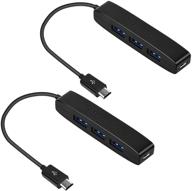

10 Review

How to use your Amazon Prime to buy Device Servers
Amazon Prime provides fast, free shipping on millions of items along with other benefits like streaming media and discounts. If you need to purchase device servers, you can take advantage of your Prime membership to get quick delivery and great prices.
Finding Device Servers on Amazon
Amazon carries device servers from top brands like Lantronix, Perle, B&B Electronics, and more. To find them, you can simply search for "device server" using the search bar at the top of Amazon's website or mobile app. This will display all matching results.
You can further refine the results using categories on the left side bar. For example, click "Computers & Accessories" then select "Networking Products" and "Device Servers". Amazon will now only display device servers in that category.
Using Prime Benefits
Once you locate the device server you need, check for the "Prime FREE One-Day" or "Prime FREE Two-Day" delivery badges. These items are eligible for fast free shipping with Prime. Over 100 million products on Amazon qualify for Prime shipping benefits.
If the device server is shipped and sold by Amazon directly, you can get same day delivery in select areas. Look for the "Deliver today" filter to find these products.
Comparing Prices
Make sure to compare the price of the device server to other listings. Check that you are getting the best deal. You can use the "Sort by Price: Low to High" option to see the lowest prices first.
Checking Reviews
Reading reviews from other buyers is wise to learn about real world experiences with that particular device server model. This helps avoid costly mistakes and determine quality.
Using your Amazon Prime membership can help you easily procure the right device server for your needs quickly and affordably. Follow the tips above to find and compare options and leverage the Prime delivery benefits.
What Are The Benefits Of Using A Device Server For Serial Communication?
Using a device server for serial communication has several benefits, including:






